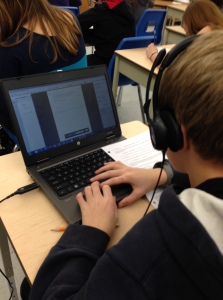Over the past few years, I’ve had some of my students use the Livescribe or Echo smartpens for various oral assessment pieces. These smartpens contain a camera at the tip of the pen which read the unique pattern of dots on the special dot paper which the user of the smartpen has written on. By creating a pencast, this pattern is replayed as it tracks your handwriting.
The dot paper is regular paper which can be reproduced using a colour laserjet printer. Students using a smartpen can write as much or little as they need with the pen. The built-in microphone allows the students to record audio, adding details to their answers that might have otherwise been lost due to their struggle to write. The audio recording of their voice is added to what they write, creating a pencast. This pencast is uploaded to the computer where the teacher can see and hear the student’s thinking.
This year in my classroom, there is an increased need for accommodations during assessment, specifically reading the test to the student. While all the students had initially been trained on programs which provided text-to-voice, the students weren’t using them, finding them “glitchy, took too many steps”. Without extra support in the classroom, it’s difficult to meet the students’ needs. For this reason, I was determined to learn how to add an audio recording of me reading the test which the student could easily follow and replay as much as they needed.
Here’s how:
1. Convert text to pdf: I write my test in Google Docs, then download it as a PDF (File, download as..). Save where you can easily find it.
2. Print the test onto the dot paper: Make sure your bottom margin is large enough (1 “) so your text doesn’t overlap the record/stop buttons on the bottom of the dot paper).
3. Record your reading of the text: Use this printed test to complete your audio recording using a smartpen. I draw a circle or star beside each question as I read the test so students know where I am. You could also click stop after each question was read, then record. Regardless, students can replay as much as needed before moving on.
4. Upload pencast to Livescribe: Connect the smartpen to the computer and the recording is uploaded. The only visuals that appears on the page are the circles that I drew (see below – no printed text).
5. Convert recording to a pencast pdf: right click on the page, choose computer, choose audio pdf. Save.
6. Add the text to the pencast: Open Adobe Acrobat Pro, then find and open the just saved pencast.
7. Add the text as a watermark: Click – Document, watermark, add. Browse – find your text pdf on your desktop. Unclick “scale to relative target page”, OK.
8. Email the file(s) to your students. They open it with Adobe Reader (version 10 or higher should be loaded on their computer (free)).
Link to the actual pencast. Download, then open in Adobe Reader. Cellular Transport Quiz pg 1 final pencast pdf (1)
So what did the students think?
“It was easier.” “I could just click the download, and it started.” And the surprise comment (and my favourite)..
“I liked hearing my teacher reading to me.” 🙂

